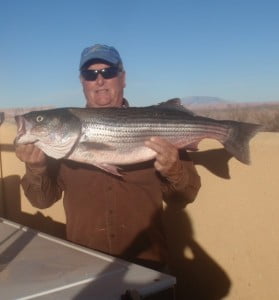Photo: Bill McBurney reported catching an
19 pound striped bass while fly fishing in the southern lake this past week.
Striped bass are coming shallower in warming water making them easier to catch
by trolling and casting.
Lake Powell Fishing Report
March 26, 2014
Lake Elevation: 3575
Water Temperature 52-60 F
The weather is warming but the changes are subtle. On calm warm days surface temperature spikes from 50 up to 60 degrees or higher. The cold winter water is still below so warm water floats only on the surface. Then on windy days the warm surface layer is mixed into the cold water. That warm layer is not completely lost as it starts warming the deep layer. Each calm period will hasten the warming. Spring warming starts all kinds of fish activity. Here is what is happening this week.
Some striped bass schools have been holding at 60-75 feet but there is now a division between adults and young. Young stripers are eating plankton that is found most readily in the upper 25 feet. Young fish have moved shallow leaving the older fish at 30-60 feet.
Anglers can take advantage of this behavior by searching the backs of canyons where water is murky. I know this is mentioned in every spring fishing report. It is emphasized every time because it makes all the difference between catching and not catching fish. Pay close attention to water color. Main channel water is clear and blue. That water color is not conducive to catching fish in early spring.
Near the back of the canyon water color may change to green, murky or muddy. Start fishing at the color change. Juvenile stripers will be randomly scattered in the upper layers as they pursue plankton schools. The best technique is to troll or cast medium depth crankbaits that run at 12 feet. When we tried this technique this week we found willing 2-pound stripers in the back of all three canyons fished in Padre Bay. Success was not quick but it was consistent.
Back at the fish cleaning station we found all stripers were mature males. It is common to catch only male or females stripers depending on the circumstances. On this day the small warming event was enough to put a chip on the shoulder of the males, while females could care less as spawning thoughts do not occur for them until water temperature reaches 70. Males were striking at lures that invaded their personal space while females were either absent or without aggression. Springtime fishing is subtle.
Adult stripers are deeper and can be found in the backs of the canyons where depth changes abruptly from deep water to a 30 feet plateau or bench. Best techniques are down rigger trolling, spooning or bait fishing.
Bass react to warming by moving up as well. They seek warm water to recharge their batteries. Smallmouth don’t even wake up until water temperature hits 57 degrees while largemouth get excited when temperature is 53 or better. Current temperatures mark the beginning of spring for both species. Calm afternoons are the best time to fish for bass, particularly in shallow coves with a south facing rock wall that collects as much heat from the sun as possible and transmits that warmth into the water. Again look for bass in colored water. Murky water warms more quickly than clear water. Bass will move to warm spots along the shore. Use the thermometer to find “hot spots”. Then look for fast falling broken rock piles to key in on bass habitat. In the absence of brush rock structure and water color will guide you to bass country.
Use the same strategy to find crappie. They will be found in open water between the muddy and green zones in the backs of canyons. Start fishing in 12-15 feet of murky water by blind casting or very slow trolling.
Fishing is not yet fast but it is certainly worthwhile to be on the lake during a calm warm afternoon.




